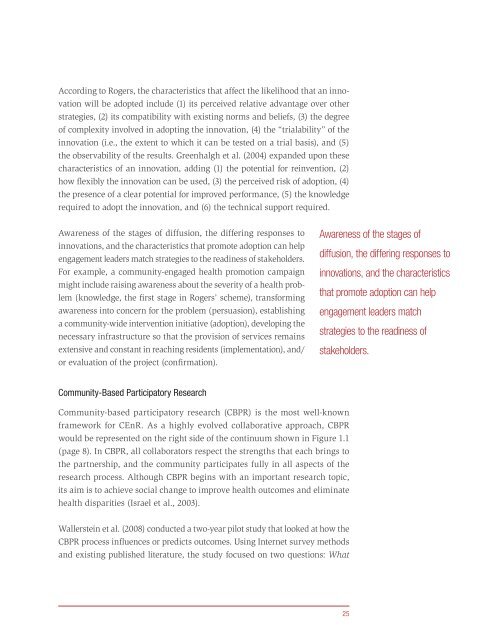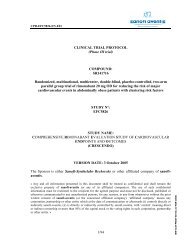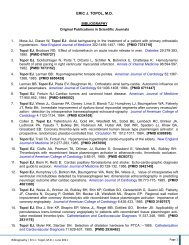Principles of Community Engagement - ATSDR - Centers for ...
Principles of Community Engagement - ATSDR - Centers for ...
Principles of Community Engagement - ATSDR - Centers for ...
- No tags were found...
You also want an ePaper? Increase the reach of your titles
YUMPU automatically turns print PDFs into web optimized ePapers that Google loves.
According to Rogers, the characteristics that affect the likelihood that an innovationwill be adopted include (1) its perceived relative advantage over otherstrategies, (2) its compatibility with existing norms and beliefs, (3) the degree<strong>of</strong> complexity involved in adopting the innovation, (4) the “trialability” <strong>of</strong> theinnovation (ie, the extent to which it can be tested on a trial basis), and (5)the observability <strong>of</strong> the results Greenhalgh et al (2004) expanded upon thesecharacteristics <strong>of</strong> an innovation, adding (1) the potential <strong>for</strong> reinvention, (2)how flexibly the innovation can be used, (3) the perceived risk <strong>of</strong> adoption, (4)the presence <strong>of</strong> a clear potential <strong>for</strong> improved per<strong>for</strong>mance, (5) the knowledgerequired to adopt the innovation, and (6) the technical support requiredAwareness <strong>of</strong> the stages <strong>of</strong> diffusion, the differing responses toinnovations, and the characteristics that promote adoption can helpengagement leaders match strategies to the readiness <strong>of</strong> stakeholdersFor example, a community-engaged health promotion campaignmight include raising awareness about the severity <strong>of</strong> a health problem(knowledge, the first stage in Rogers’ scheme), trans<strong>for</strong>mingawareness into concern <strong>for</strong> the problem (persuasion), establishinga community-wide intervention initiative (adoption), developing thenecessary infrastructure so that the provision <strong>of</strong> services remainsextensive and constant in reaching residents (implementation), and/or evaluation <strong>of</strong> the project (confirmation)Awareness <strong>of</strong> the stages <strong>of</strong>diffusion, the differing responses toinnovations, and the characteristicsthat promote adoption can helpengagement leaders matchstrategies to the readiness <strong>of</strong>stakeholders.<strong>Community</strong>-Based Participatory Research<strong>Community</strong>-based participatory research (CBPR) is the most well-knownframework <strong>for</strong> CEnR As a highly evolved collaborative approach, CBPRwould be represented on the right side <strong>of</strong> the continuum shown in Figure 11(page 8) In CBPR, all collaborators respect the strengths that each brings tothe partnership, and the community participates fully in all aspects <strong>of</strong> theresearch process Although CBPR begins with an important research topic,its aim is to achieve social change to improve health outcomes and eliminatehealth disparities (Israel et al, 2003)Wallerstein et al (2008) conducted a two-year pilot study that looked at how theCBPR process influences or predicts outcomes Using Internet survey methodsand existing published literature, the study focused on two questions: What25










